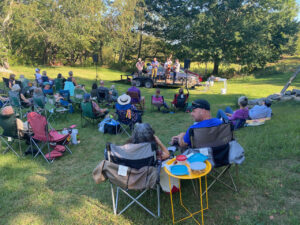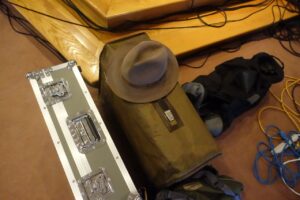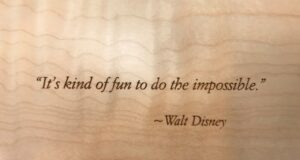November 24, 2023…8:20 AM… things are looking bleak…but are they?
This picture will make sense in a bit…read on. So it’s kind of a year since things started opening up after the worst of the virus, and where are we? The Taylor Swifts of the world are in great shape, with young people more than happy to pay idiotic prices (thanks to the Ticketmaster/Live nation monopoly, but that’s another story) for big shows. For the mid-sized and performing arts venues, it’s all about R.O.P. (really old people) dredging up tunes from the bands that made them famous 50 years ago, or younger people performing in tribute bands that play those same tunes from 50 years ago. And booze. Classic rock and booze, that’s what makes the dough.
As for trad music and smaller venues, like our church venue, well, the audience has been shrinking for years, and the virus simply hastened that process. More small series across the country closed up shop over the past couple of years than ever before. A few house concert spots have opened up, which is great, but can a touring band survive on 70 people a night, especially with travel expenses being what they are?
When I speak with agents and other venues, we all see a disturbing trend for folk music, and here are the headwinds:
1: Audiences getting older, without the traditional backfilling of younger families bringing up the numbers and taking the elder’s places.
2: Volunteerism has disappeared, killing off more than a few smaller festivals and programs.
3: No one is all that excited anymore about sitting in churches or halls to just listen to music, that might be a little strange, in less-than comfortable chairs or pews with no alcohol.
4: From the artist side of things, we’re not seeing many really new and exciting young performers that fit the bill of talent, performance quality, tour ability (as in meet costs, willingness to suffer cars and cheap hotels, etc) and skill and energy to help promote themselves.
5: Costs of travel are killing everyone, from musicians to the venues that have to help absorb these costs.
Brighter spots:
1: People LOVE being outdoors. Festivals are doing well, and outdoor shows we do are really popular. Yeah, you’re weather-dependent, and that’s a nail-biter, but it’s simply more fun. Add in food and it’s a fun local event for all.
2: Younger families are out there, and they are doing stuff. Just not the stuff they were doing 10 years ago. This isn’t a problem exclusive to folkie music, it’s all over: churches, scouting, all sorts of things have seen the decline. Where did they all go? It can’t just be youth sports, which are indeed over the top (I’m pretty sure most colleges don’t ask how many soccer games you’ve played before you turned 16) and I’m also not convinced it’s just phones and computers that have sucked the brains out of the population. When we hike up in the White Mountains or Vermont, we’re amazed at the number of young people climbing mountains. It’s great to see.
My wife who plays in a local symphony orchestra, is also thrilled to see so many young professionals and college or grad students joining the orchestra and loving the act of playing cool classical music with lots of like-minded people. Between the outdoors and the symphonies, it’s clear to see that the younger generation is there and active, it’s more that out present way of doing things is just not the way to do it any longer.
Perhaps to turn the tide, we simply need to take the music to the people, which means nothing more than heading outside, or to random spots where the young folks are. I’m thinking there needs to be a whole new wave of folk clubs, considerably more modern in beverage and food offerings, devoted to the sort of music we put on. Jeremy Kittel drew younger people, as well as Damn Tall Buildings. It’ll work, we old-school presenters just have to change the way we think and do things. The musicians also need to buy into the fact that they’ll be doing things differently as well. School visits, busking in each town, whatever it takes to help promote their shows. It’s going to take effort on all sides to turn this ship away from the rocks, and those who don’t get on board will be sinking in the sea.
November 6: Order from chaos, yes, but is it good? Two big Questions and the need for the Garage Venue.
The results are sort of in: the pandemic didn’t stop the music industry, but it changed the little guys, for sure. It’s a pop world now, more than ever. Many a venue that was once a place that held a variety of types of music have gone for the bucks (hard to blame them, money does indeed pay bills) to pop/rock halls. Some have gone so far as to remove the seats that older people like to watch their old favorites in, so that they can fit more people standing up close to the stage and dancing. How long will tat trend last? Who knows?
For the non-profit performing arts centers, it seems that the transformation is now complete, and the mid-sized performing arts venues have morphed into strange bars/restaurants with unusual seating arrangements that use old rockers and tribute bands to push sales.
Question #1: Where do the more adventurous artists get their shots at presenting their work? The remaining venues that present these sorts of musicians are usually much smaller, some as small as 40 people. How can anyone make enough to live on with that small an audience? There are a couple that hold as many as 90 or so, but they’re rare. The church-basement sort of program that gave so many of these a start are in trouble. The volunteer base was ancient before the virus hit, and many now have given up the ghost. Which brings us to question number 2.
Question #2: Where are the 20-40 year-olds? You’d think they were in to more adventurous music, or at least a certain percentage of them. Do they simply listen at home? Are there so many music delivery options now that all they do is stream? Is going out to a concert more of a social event, and less about the music? In truth, going out to live music has always been a social event, but the willingness for trying new music in a live setting seems to have disappeared. The older folks come. Is it a generational thing? Are people who grew up in the 60’s and 70’s and are used to listening to revolutionary folk and rock music still into trying new things? Are people who grew up in the 80’s and 90’s used to being fed a computer-selected radio program?
Getting the younger generations to try new live music is actually a critical issue. It’s more than just about a few musicians trying to make a living, it’s about the inspirational effect of experiencing new thoughts with others in a group setting which then energizes the creation of more adventurous ideas.
If all the great rock groups (at least in our boomer minds) were once garage bands, we need to get people to start new garage bands…though maybe they’re not garage bands…. they’re garage venues or garage spaces where music and tech and ideas can all merge. As long as there’s good pizza, I’m in.
September 23: Assessing The Madness, winners and losers
Now that there’s been a few months of what we can refer to as a “semi-reopening”, what’s new with the live music scene? It was going so well until the Delta variant hit, and that set things back a bit. Far enough back, in fact, that I believe there is a pretty large shift in the folk music world. First off, what can’t be understated is the effect that vaccines have had, and the willingness and unwillingness of people to take them. We now have two distinct music-going audiences. Vaccine-only tours and venues are now the norm, and it’s equally normal to see spots that don’t require vaccines or much of anything else, for that matter. It’s not just the venues that call the shots: touring artists are equally adamant about playing to vaccinated-only audiences. I have had several hard-driving agents say that it’s absolutely ok to limit the size of audiences just so that the show can go on, something unthinkable two years ago.
The Winners: Craft brewers, distillers and wineries and local musicians. This category didn’t really even exist pre-pandemic. Yeah, there were craft breweries, but most were pretty basic. Then with the virus, in order to open, they needed to serve food. Most all farmed this out to food trucks, and they set up elaborate outdoor spaces for people to enjoy without fear. Business boomed, way beyond pre-pandemic levels. A new business n=model was born, and the smart ones also added live music. The key seems to be to add really good music, not just any local cover band. An excellent example is Maine Craft Distilling which has no less a person than Joe K. Walsh running a Tuesday evening bluegrass pickup band.
The only downside is for the competing venues: this is too hip to ignore, and will absolutely draw music lovers away from other venues. On the whole, though, for musicians and music lovers, it’s a big win.
The Losers: The smaller church-basement, love-of-music, all-volunteer type concert series.
There’s one undeniable fact at this moment in time: the biggest single factor affecting live music is fear. The musicians aren’t totally affected by this, they can dictate protocols and stay a bit away from the audience. The fear of the audience members is a large factor, for sure, as they will determine the sort of venue they’re willing to attend, as well as the density of the crowd. This past week, we were to have a concert indoors, but fear of the variant was keeping a number of people from attending. In a last-minute experiment/audience-building move, I moved the concert outdoors, and almost immediately the audience grew in size. So yeah, comfort is a factor to the folk/acoustic music audience, no matter what anyone might say.
But who wants to sit in a tightly-packed, poorly ventilated church or similar space? Not many right now. As of this date, smaller series are cancelling their shows left and right, or telling the artists that their income will be greatly diminished, rendering touring unprofitable. For most tours of two weeks or so, when all travel expenses are added in, and taxes subtracted, all the profit comes from the final two dates. If two dates out of every tour are cancelled, well, you guessed it, no tour.
The biggest issue facing the small venues right now? Lack of volunteers. They’re both nervous about sitting in a packed room, or simply done with the idea of volunteering. Most were older, and after 16 months off, many have found that they like the extra free time. I know a bunch of ours have simply said, “Hey, it’s some else’s time to jump in and help.” That’s totally understandable; especially since many have been hard workers for years.
I received my volunteer sign up solicitation for a local performing arts festival the other day, and even though it’s just a few days away, virtually every time slot over three days needed helpers. That’s a huge labor gap from several years back, when the number of willing volunteers far surpassed the available positions.
I do know of several of the small series that are considering packing it in. Let’s hope not, but their labor pool may have simply aged out.
Breaking Even: As for the bars and performing arts centers that need to book shows to stay alive? No change; they’ll still be pushing pop, rock, tribute bands and surviving classic rockers, selling alcohol and munchies to make their payroll and hopefully a little profit. The same goes for the big amphitheaters, the big shows will always sell. I hope they all last, as we need as much music around to make the world a happy place.
June 7: The Reports Of Live Music’s Death Are Greatly Exaggerated
I believe I’ve read about 473 articles over the past few weeks all sounding the alarm that live music is dead. It would be a classic case of dominoes falling: first musicians, then venues, then recording studios, sound guys, booking agents, etc. As venue operators/presenters, we need to see how it all fits together, we’re in the middle of bringing musicians and audience members together. What I see is short term pain, but in the long run, a far healthier universe for live music.
First, it’s critical to realize that the “music biz” is hundreds of different businesses. Does anyone really think the economics for a Taylor Swift are the same for some little local bar room blues band or or experimental classical music performer? I’ll go so far as to say this, and I’m betting it’s largely accurate: anyone you’ve heard of (unless your a fan of aforementioned experimental classical/noise generated electro-cello music) will be fine. The big venues will be fine. The amount of money that is held by the conglomerate Ticketmaster/Live Nation, in partnership with the large venues and artists is so great that they’re sounder than just about every national retailer.
For all the rest? That’s where the work needs to be done. By and large, save for a few performing arts centers, the bulk of music happens in bars or restaurants. Some may masquerade as a music venue, but make no mistake: without alcohol, they’re doomed. Some, like a City Winery, may shoot high with excellent food and beverage, while others are little more than rooms with folding chairs and an extensive beer list. This in no way denigrates that business model, it just shows that it’s a very pandemic-sensitive business model: no bar service means no music. Even those larger performing arts centers need the alcohol sales to survive. It’s a long-help tenent that the last two rows of seating are where the profit is for the smaller arts centers. If those don’t sell, you’re in trouble. Alcohol sales insure the venue from that worry. For many mid-week gigs,. the alcohol is what pays the band, not the cover charge.
Those folk clubs, the old survivors of the ’60’s that are still going, are slightly less vulnerable in that many have gone to non-profit status, which has enabled the stronger ones to develop a sound donor base and endowment. While things won’t be easy, especially for any employees of these clubs, they should able to come through the other side.
The “low venues on the totem pole” are perhaps the strongest in a situation like this. The volunteers who run those church basement or library hall music programs will weather this with relative ease. With no fixed expenses, there is no financial drain. The people who run these programs never were in it for the money; they never took a salary or cut of the door, so the lack of income isn’t a concept that relates to their venues. Yet, they’re the most important for the niche musicians who aren’t Taylor Swift. They put on the shows by the unknowns, in the weird genres that aren’t even labelled, and pay splits to the artists that are far greater than anywhere else. The people who run these programs simply do their day jobs until it’s financially viable to run shows again.
What was going wrong with the smaller side of the music business that this pandemic helps? Plenty. The first problem was that there were too many venues. Every fan with a living room started hosting house concerts. Every book store, music shop, church, bar, etc all started music programs. While initially the artists themselves thought this was great (More Gigs!) a few started to realize the music product in general was starting to be diluted. Their own individual brand, specifically, was in danger of becoming ordinary. It got too easy to book a week’s worth of gigs in one area, especially the low-paying house concerts.
The venues that had “skin in the game”, i.e. fixed expenses that they were willing to risk for guarantees, sound equipment, rentals, etc., had a hard time standing out. With music on every corner, on every night, for low prices, even the best players became ordinary. So what happened? To make sure that they could get a crowd, many of the well-paying larger performing arts centers turned to their most reliable audience members: old people looking for nostalgia. Why take a chance on some challenging new classical or jazz when you could throw a tribute band up there and sell the place out? So in an instant, all this talk of “music being inspiring, of enlightening, of educating and communicating new ideas” was just talk. You wanna stay alive? Get the Led Zeppelin knock-offs.
What was an already-difficult position for many arts organizations attempting to present more niche music became worse with the pandemic, and musicians weren’t helping. While these cell-phone concerts were fun for the first weekend, and generated a little income out of sympathy from the faithful fans, they quickly became too common. Musicians were Streaming Live! at every opportunity with poor sound and video. Worse still, they were unprepared for what a small screen does. It focuses everything just on them. A stumble with between-tune patter, or worse, a constant looking away or even walking off screen for a second, is magnified: there’s no one else up on the stage to distract the audience from an intense focus. As there’s no sound “help” from a large hall (think auto-reverb with sound-diffracting qualities of an audience, essential to live sound quality) even the best musicians sound pretty lame. In fact, even really talented ones looked quite ordinary. For a venue like mine, it’s hard to get excited about booking artists in the coming year who now appear quite ordinary.
WHAT CAN BE DONE?
We are now officially in the era of video selling music better than music can. Artists, no matter how small or esoteric, need some really great videos to back up their promotional efforts. There’s going to be quite a log jam of artists looking for gigs in the coming year. Many of those available slots will go for events and shows that had already been cancelled, and are needing to be re-booked. That means an artist can possibly have missed most all of 2020, and then still be out of luck in 2021 if they don’t have the proper promotional program behind them. Use this enforced downtime to really up your video game. I believe that most people will forgive superb quality if the content is creative and engaging. While more than a few agents disagree with me, performance videos don’t cut it. They’re a cheap way out. I might use one or two just to preview how an artist engages a crowd, but that’s about it. Get creative, please.
And it’s not just up to the artists: venues who are on the fringe of mainstream will need to get really creative to make shows profitable when we can all open up again, and are limited to audience density or size. Can it be done? I believe so, but the goals have to be different. While I can’t say what will work for everyone, I’ll share what I believe will work for my situation.
I have a mid-to-small sized venue, but much larger than city clubs. I can hold up to 200 people, but if I lay out a 6-foot perimeter around various family units, I’m really only looking at about 50-60 people. That’s a big hit, and if I pay headliners with full bands their guarantee from a year ago, I’ll lose about 70% of the normal gate. That means, with one show, I’ll have lost so much money that I’ll have to shut down permanently. On the flip side, I won’t be able to fit a full band on stage while maintaining distancing anyway, so part of that issue goes away on it’s own.
In the very short term, I’ll probably book only duos, and either married ones or partners who live together. That allows them to stay close on stage and actually look like a unit, which is the point of their music. Fortunately, there’s more than a year’s supply of very talented couples to make this part work. There are alt/classical duos, folk, hard-core fiddle partners, R&B, you name it.
The other benefit for the musicians is that because they live together, they can travel together, share a room, and keep their expenses well under control. They need a lower guarantee to make the tour work.
For my part in helping them earn as much as possible, I’ll need to do the dreaded live-streaming thing. Yes, I’m not a fan, but as a supplement to their live show with a limited sized audience, it should help a little. I can also link to a local charity during that stream to help with their fund-raising as well. The artists now becomes part of a community, which in the long run will help with their own support on platforms such as Patreon.
In addition, we will start offering the pre-show workshops more often. The artists will get paid a little for this, and it helps with the pre-show publicity. If desired, we can even try to arrange private lesson masterclasses for the artists the day of the show (or eve the day after, depending on their tour route). Again, it’s community-building with a little extra income for the artist. This approach may or may not work, but it’s better than doing nothing.
As with any event causing great change, there will be winners and losers. The losers will whine, posting on social media about how tough their life is, linking to every article about how the world will end. The ones who make it through will be much stronger, with less competition. They’ll be the venues working to make the audience’s experience even better through better ambience, more access to artist interaction, perhaps investing in better sound equipment. The artists who excel in the coming year will the ones producing better videos, working on new material, perhaps initiating new collaborations they never thought of or had time for before.
In the end, the musical experience for everyone involved will be much better, and I for one am looking forward to it.




